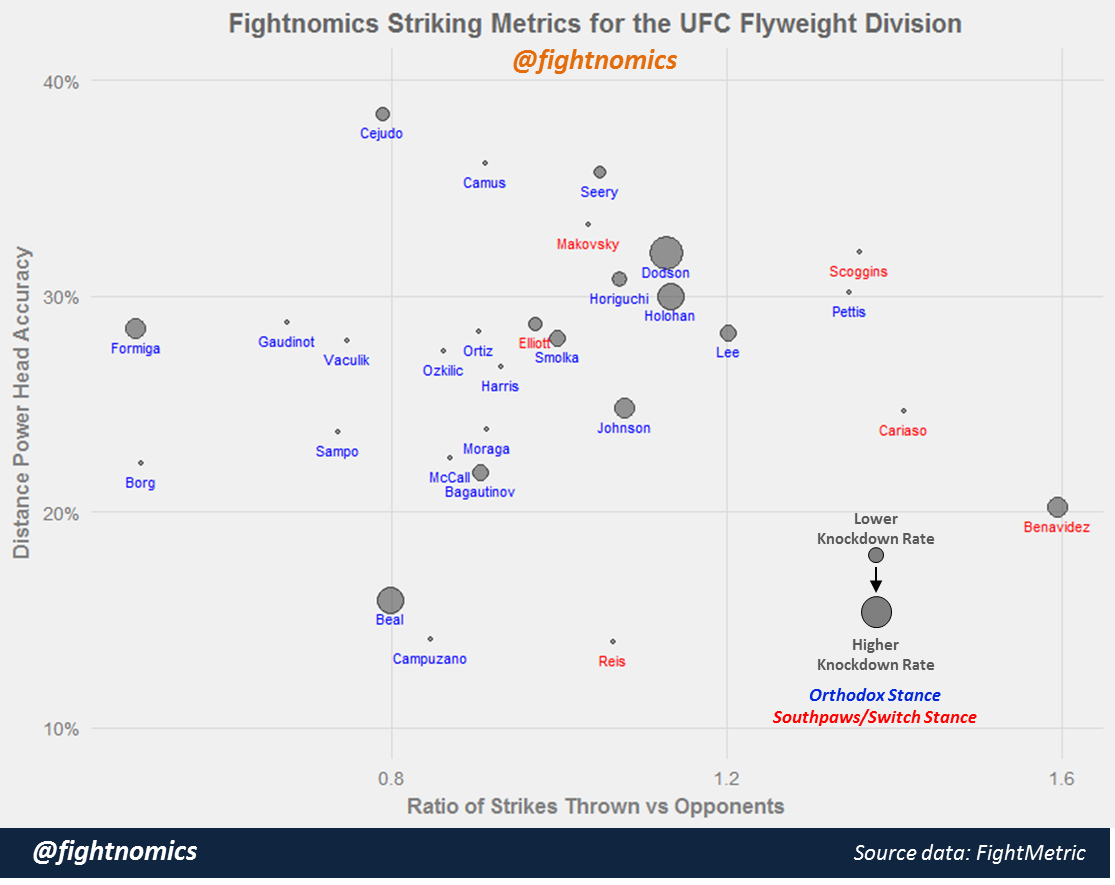Striking Assessment: The UFC Flyweight Division
By @fightnomics It’s the last remaining men’s division that has only known one champion. Demetrious “Mighty Mouse” Johnson has reigned over the UFC Flyweight division since inception, with 7 consecutive title defenses so far, and without ever having to take time off or for allow an “interim” title. But that domination will get put to the test by his most threatening former challenger, and as we’ll see there’s another threat down the road from a new arrival in the division. So let’s turn our attention to the UFC Flyweight division’s striking metrics. For similar prior analysis follow these links for the Light Heavyweights, Featherweights, and Heavyweights. How the Graph Works This balloon (or bubble) chart includes all active UFC Bantamweights who have competed since 2013 with sufficient data. Some of the names are clearly retired or no longer with the organization, but were left in here for reference. There’s also a few more that didn’t have enough data, or have been inactive for a while who were excluded. The four metrics in the graph are all related to striking (we’ll look at key grappling stats later). First, the vertical axis is the power head striking accuracy. This is a general reflection of a striker’s skill level in technique. But some fighters are more aggressive than others, while some are primarily counter-strikers, and those characteristics lead to very different striking styles. So the horizontal axis indicates the ratio of strike attempts while standing compared to the same fighter’s opponents. It’s a measure of output, and a proxy for aggression. An even 1.0 ratio means a guy matches the pace of his opponents when standing and trading, while a higher number shows more aggressive and higher-volume strikers compared to lower ratios indicating counter-strikers. The dots are plotted based on those two metrics, but two more variables are also shown. The size of the bubble is based on the fighter’s Knockdown Rate in the UFC/Strikeforce. Bigger bubbles mean a lot more power, while the small specks indicate fighters who haven’t logged a knockdown in recorded competition. And lastly, southpaw/switch stance strikers are in red. Lefties are rare, but are worth highlighting as most fighters have trouble with Southpaws. 
Click to enlarge.
This division lacks the knockout power of the larger weight classes, and so you see a lot of small dots on the graph representing fighters who have yet to score a knockdown. In fact, those small dots are 16 out of the 30 fighters shown here. There’s a lot more variance in style and skill. The accuracy of this group ranges from just 14% all the way up to 38%, and there’s a similarly wide spread in terms of how these fighters throw volume versus their opponents. But in each of the three performance metrics, there are very clear winners. And as we’ll see, these high-performers are all near the top of the division. Snipers Surprise! Olympic Wrestling gold medalist Henry Cejudo is definitely not a one trick pony. In his three fights in the UFC to date, two of them were almost entirely standing matchups, and his striking was spot on throughout. He leads the entire division with power head striking accuracy of 38%, two points higher than the nearest peer, former opponent Chico Camus. The fact that Cejudo’s hands have gotten him through several UFC fights to date bodes well, because being well rounded is a requirement to face current champion Demetrious Johnson. Cejudo is also one of the fighters who has scored a knockdown, meaning there’s also some power behind his precision. It’s very likely that we’ll see Cejudo challenge for the title with just one more win, and we should expect that the competitiveness of the Flyweight title picture will become very interesting. High Pressure Strikers Joseph Benavidez is a two-time title challenger and was the early front-runner to take the belt when the division was first created. He’s also the most aggressive volume striker in the division, having outworked opponents by a whopping 60% on average throughout his career. Part of Benavidez’s style is to make opponents hesitant, because he’s not working at a barnburner pace. Perhaps the threat of his ground game has opponents more worried about takedowns than returning fire. Regardless of losing two shots at Johnson’s belt, Benavidez is a permanent fixture near the top of the Flyweight ranks. Sluggers This division doesn’t have a lot of power, but one fighter stands above all the rest and it isn’t even close. John Dodson has scored seven career knockdowns in the UFC, with an 8% Knockdown rate that is nearly twice the Heavyweight average. Pound for Pound, you could argue he’s one of the most dangerous strikers in the UFC. And two of his career knockdowns came against current champions: Demetrious Johnson and Bantamweight Champ TJ Dillashaw. Dodson’s threatening speed and power are undeniable, regardless of weight class. Second place could have gone to Brazilian slugger John Lineker, but he has missed weight enough times that he’s been banished to the Bantamweight division. We’ll see him later when we consider the next division up. Division’s Next Title Fight The title rematch between Demetrious Johnson and John Dodson is more compelling than many recent Flyweight title fights, because we’ve seen Dodson actually come close to upsetting the champ in the past. Johnson’s all-around MMA game is elite, but all the skill and preparation in the world can’t save you if a nasty strike lands on target. Johnson’s striking stats are some of the best in the division, so he’ll likely want to stand and trade and headhunt with big strikes. But if Dodson doesn’t get the KO, he’ll need an answer for Johnson’s relentless kicks and takedown attempts if there’s any chance for an upset on the cards. The likeliest scenario is that Mighty Mouse survives again, and then faces Cejudo next. “Fightnomics” the book is now available on Amazon!